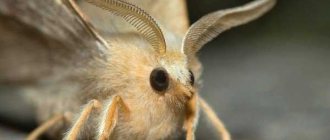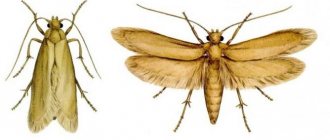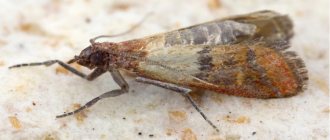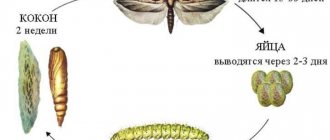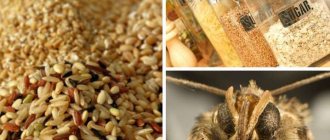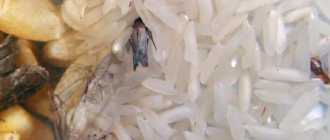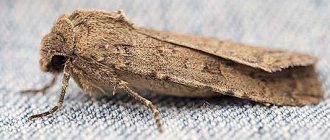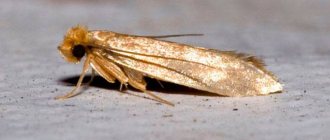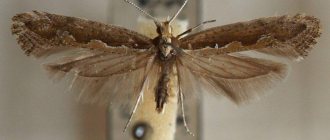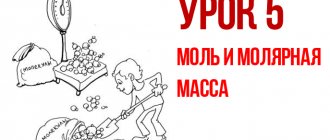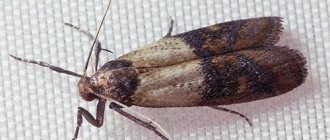House moths or clothes moths are known to residents of all apartments and houses. Every person at least once in his life has encountered the consequences of the pestilence of this lepidopteran insect - damaged fabric, winter clothes, coats, expensive dresses, silk upholstery. All this turns into a canvas with holes, unsuitable for further use.
Some interesting facts about house moths:
- unlike other members of the family, this species does not flock to fire and light;
- adults and larvae practically do not fly; they crawl on clothes, furniture and other objects;
- Only clothes moth larvae spoil things by eating fabric;
- It is very easy to recognize the activity of the larvae by the exposed tissue base left behind;
- plastic bags and synthetic fabric are not able to protect the product from pests, since the larvae are able to gnaw through such material without any problems.
To protect against clothes moths, people use improvised and folk remedies and purchase special repellent drugs in stores. How effective they are, what the indoor pest looks like and other features of the insect will be discussed in the article.
What does a thing moth look like (photo)
Clothes moth.
Why does he eat clothes?
Anyone who is faced with the appearance of pests in the house is interested in questions about why and how moths eat clothes. That food is necessary only for pest larvae for growth and development. Imago, that is, adult individuals, do not need food. Over the course of their life, which is about a week, they use up the energy reserves stored in the larval stage.
The nutritional features of moths include the need for protein, which is contained in natural fabrics, feathers, and fur. However, in the absence of their usual food, caterpillars may begin to eat synthetic fibers. Such a diet slows down the formation of the pest, but allows it to receive a sufficient amount of substances necessary for the transition to the next stage.
Main characteristics of the pest
Name: House moth Lat.:
Tineola bisselliellaClass: Insects - Insecta. Order: Lepidoptera - Lepidoptera. Family: True moths - Tineidae.
| Habitats: | cabinets, furniture |
| Dangerous for: | fabrics, furs, upholstery |
| Means of destruction: | traditional methods, chemicals, traps. |
Moth caterpillars.
Many people mistakenly believe that if their home is kept in order and clean, then these pests are not afraid of them. But in vain, because moths do not start from dirt.
She loves things made from natural fabrics such as wool and fur. She does not disdain cereals or other loose ingredients left unattended in the kitchen.
Such components are present in every home, so you need to always be on guard. In addition, if there is a moth in a neighboring apartment, then it is possible that it can get into the home through open doorways, vents, or cracks.
You can bring it with purchases from the store, with things or furniture that were used by other people.
What does it look like and where does it lay eggs?
The clothes moth looks like a fairly large butterfly. Its wingspan reaches 23 millimeters. The color of the wings is predominantly sandy, with a purple tint at the base.
She lays eggs in dark, hard-to-reach places, in folds of fabric, under collars and cuffs, in pockets, and in the recesses of textile seams.
Life cycle
The complete development cycle from egg to butterfly takes from one to two and a half years. Having hatched from the pupa, the butterfly immediately looks for a sexual partner and mates. In two weeks she lays about 50 eggs. After laying eggs, which takes seven days, the female lives for a few more days and dies. The male continues to mate until the end of his life.
Life cycle of a moth.
Damage
Moth damage on clothing.
Adult larvae crawl on clothes and furniture. The most dangerous are only the larvae that hatch from the eggs. They destroy and chew everything in their path, even synthetics and plastic bags.
Once the toothy larva has reached the item, all that remains is to throw it away. Such things, as a rule, cannot be restored.
What does it eat?
Clothes moths usually live in closets, furniture, attics, pantries, and anywhere there are fabric-upholstered items and clothing. Their favorite food is fur coats, woolen items, linen, cotton, natural angora, silk, and cashmere.
Prevention measures
Moths can easily appear in any apartment, regardless of sanitary conditions. At the same time, she does not stay in every apartment due to unfavorable conditions. Since they cannot lay eggs under their usual conditions, they have nothing to do in such a dwelling. By following a number of very simple rules, you can reliably protect your home from pests.
You need to proceed as follows:
- Regularly ventilate closets where clothes are stored, and at the same time check things for the presence of such pests. Particular attention should be paid to items made of fur, leather, knitted items, and natural wool.
- Take things outside or onto the balcony if it is open. This can be done both in summer and winter. The larvae die both from ultraviolet rays and from sub-zero temperatures.
- Items made from natural fur should be stored correctly, without using polyethylene. To do this, use special covers, pre-treated with chemicals, or put leaves of tobacco, wormwood, lavender and other plants wrapped in gauze in your clothing pockets.
- Bulk food products also need to be stored properly in closed containers. Do not purchase bulk food products for a long period - a couple of weeks maximum. If cereals or flour are stored for a long time, then pests will definitely appear in them.
How to get rid of clothes moths
It is quite difficult to remove clothes moths. Moreover, considering the fact that caterpillars can go without food for a month. There are folk, chemical and professional means of insect control.
Regular monitoring
In order to minimize the risk of invasion, regular inspections are carried out in cabinets and shelves. Both butterflies and larvae cannot exist without giving themselves away. In their habitats there will certainly be damaged areas of tissue, gnawed pieces of fur, threads of cobwebs, cocoons and feces.
If you suspect the presence of unwanted guests, you should react immediately, otherwise trouble cannot be avoided.
Preventing or reducing infestations
Cleaning a living space infested with clothes moth larvae should be carried out with special care.
- It is necessary to pay attention to hard-to-reach places: behind radiators and ventilation holes, under baseboards and wardrobes.
- Wipe shelves and furniture with a special disinfectant.
- When using a vacuum cleaner, upon completion of work, you must immediately dispose of the contents of the dust collection bag so that the larvae and eggs that get there cannot return again.
If moths are found in a closet, you should remove all items from there and wash all surfaces.
Protecting things in the closet
Sachet for the closet.
Clothes and other items left in the closet without proper care are most susceptible to insect attacks.
Therefore, they should be stored in clean, dry form, in sealed containers, pre-treated with natural repellents, for example, mint, lavender, wormwood, or use special chemicals, dichlorvos.
Freezing and heating
Moths do not like low or high temperatures.
Moth butterflies die when there is a sharp change in temperature, and it does not matter in which direction this difference occurs. This could be temperatures above 50 or below 20 degrees Celsius.
The product, previously placed in plastic packaging, is either fried in an oven or frozen in the freezer. It all depends on the type of fabric: if it is not afraid of these types of processing, then you can safely take them into service.
Dry cleaning will help get rid of moth larvae.
The contents of the closet are reviewed for damage, and surviving clothes are washed and fried at high temperatures. Bright sunlight is not a moth's best friend; it dies in the light.
Washing is done at a temperature of at least 50 degrees and for a duration of at least half an hour. Textiles that cannot be washed at high temperatures should be dry cleaned.
Traps
Sticky trap.
Another method of control is glue pheromone traps. This is the simplest, most accessible and relatively cheap method. The principle of its operation is very simple.
The female follows the smell emanating from the trap and sticks her paws to the glue, gets stuck there and dies. You can purchase it at any specialized institution.
What does the modern market offer?
To destroy moths in a closet with clothes, you can use the following drugs:
- fumigation;
- contact.
Fumigators - moth killers
It’s probably worth starting the review of fumigation agents with the “killer weapon” itself - naphthalene. For a long time there was no alternative. It is really effective, but it has already been proven that naphthalene is toxic and unsafe for humans. It and similar, but less harmful drugs are intended for closed spaces. Place the product in your wardrobe, print it out, the active substance will gradually evaporate. The expected effect is repelling insects, as well as their death. The advantage of anti-moth fumigators is their relatively long service life.
Contact anti-moth agents
Contact group preparations are aerosols that are used to treat carpets, cabinet walls, and furniture. They are toxic to one degree or another. Moth larvae, eating the active substance, definitely die. Although, it is worth pointing out another significant drawback - the short time period of effective impact.
Traps for clothes moths
The advantage of these products is the absence of insecticides. A very popular “design”: a layer of adhesive substance located on the inside of the trap + a female pheromone dispenser that attracts butterflies. For humans, this smell is elusive, but adult males, who are attracted to the female pheromone, stick to the glue and die. Thus, the number of insects is sharply reduced, which means the intensity of reproduction decreases. The efficiency of a sticky trap is determined at 10-12 weeks.
Pheromones can be added directly to the adhesive, using adhesive tape as a trap.
Attention! It is important not to overdo it with pheromone baits, since excessive concentration in the air will cause insects to become addicted and they will stop responding to the trap. In a room of 15 sq. m. One bait is enough.
By the way, by the number of individuals stuck to the glue, one can judge the scale of the infection. In principle, it can be used all year round. If insects suddenly appear on them, this is a signal for active action.
Preventive measures
Folk remedies are often used as prevention.
Repellent plants are able to repel insects and moths with their specific aroma.
Their effect is longer than that of chemical drugs, but they are less dangerous to the health of people and pets. These include tobacco, garlic, vinegar, geranium, lily, mint, lavender, rosemary, citrus peel and many others.
Follow this link to learn more about all the ways to get rid of moths.
Reviews
- After moths appeared in our closet, we were forced to throw away most of our fur items, however, even this did not help cope with the problem. We were advised to use an excellent moth repellent – Raid fumigator. We turned it on for just a few hours a day, and literally a week later there were no traces of moths left in the entire apartment. – Irina, 30 years old.
- Since we have small children at home, we decided not to use chemicals, however, the Mosquitall aerosol did not give off an unpleasant odor and turned out to be completely non-toxic. We could deal with the moth very quickly. – Vladislav, 34 years old.
Traps
Traps are a relatively easy-to-use method that can help detect and reduce clothes moth infestations. Pheromone traps are available in specialty stores and are relatively inexpensive. Pheromones are chemicals produced by the body of a male insect, which in this case is a sex attractant that can influence the behavior of other members of the same species.
The sex pheromone lures females into the trap, where they become stuck on its sticky sides. Since the pheromone specifically attracts only moths, it will not attract other types of insects.
Easy identification
Anyone who has had the opportunity to compare photographs of food and clothing moths cannot help but notice that there are very serious differences in appearance between the two species. Cloth moths are more common than food moths. Outwardly, both of these types are similar, but each has its own characteristics. The most significant difference between fabric and food moths is in the color of the individuals. An adult clothes moth has a golden color with reddish hairs around the head, its wingspan reaches 1 cm. The moth does not tolerate sunlight, so during the day it hides in the dark corners of the toilet, behind itself, in various crevices.
Clothes and food moths
Food moths are smaller in size than clothes moths and have a darker color, approaching dark brown. They are also half the size. Both clothing and food moths fly close to the place where the main source of infection is located. The trajectory of their flight is also characteristic only of this species. Often this is a spiral or figure eight. During the flight, the moth may briefly hover in the air, as if trembling. As for the larvae of both species, they are similar to each other. The only difference is that the larva of the parasite that infects things produces a thin web that serves as the basis for the cocoon. Multi-colored grains of sand are also visible around the affected area. These are colored excrement of larvae, their color depends on the color of the fabric dye.
Use of insecticides
If moths are found on things that cannot be dry cleaned, washed, heated or frozen, you will have to treat them with chemical insecticides. Finding a product that contains a picture of a moth on the label is not difficult, you just have to specifically follow the instructions on the back of the package.
Insecticides for clothing moths usually contain pyrethrins, which provide a quick knockdown of the insects. You can spray most of these products directly onto fabrics. Pyrethrin-based insecticides do not leave a persistent toxic residue, making them more suitable for controlling clothes moths.
However, some sprays have an oil base and should not be sprayed on silk, rayon or other fabrics that are easily stained. Also, do not use sprays around open flames, sparks, or electrical circuits.
If in doubt, I would like to share the following information as advice. First, spray a small amount on an inconspicuous area of your clothing and let it dry to see if staining or staining occurs.
Regular monitoring
In order to check for the presence of pests, the first thing you need to pay attention to is whether there are threads of cobwebs in hidden parts of clothing. It is also possible that there are tubes left behind after insects pupate. The area where these tubes are most common tends to have a lot of damaged clothing fibers and insect feces. The same picture can be observed in fur items, where, among other things, baldness can be observed, and when lightly tugging on the remaining fur, it will separate in large clumps.
Dry cleaning and anti-laundering
The most common and effective method for killing all life stages of moths in clothing, blankets and other washable items is classic washing or laundering. A thorough washing process should not take less than 20-30 minutes in water that is heated to at least 50 degrees Celsius. Since many woolen items should not be washed in hot water, dry cleaning these items may be the only viable option. Storing clean fabrics has another benefit - insects are less likely to infest them.
